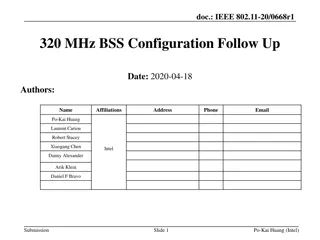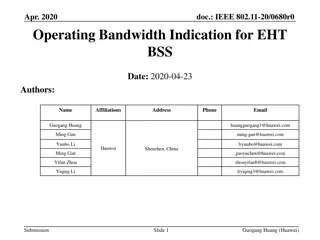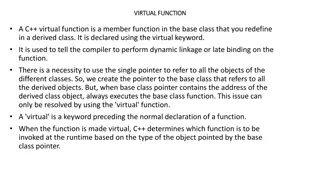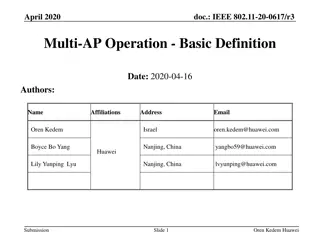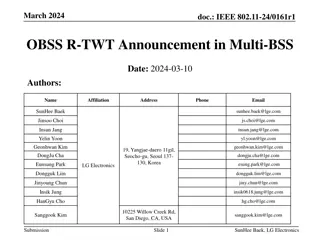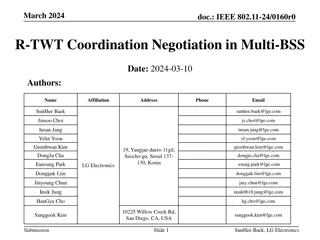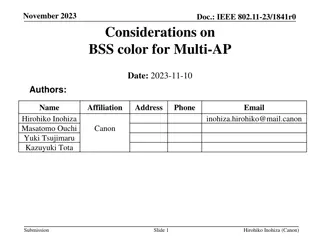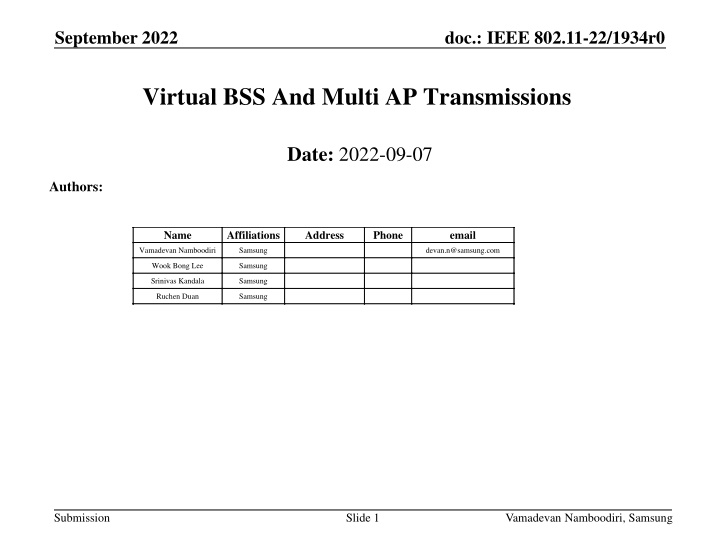
IEEE 802.11-22/1934r0 Virtual BSS and Multi-AP Transmissions Overview
Explore the key concepts of Virtual BSS and Multi-AP transmissions in IEEE 802.11-22/1934r0, focusing on enhancing WLAN reliability, reducing latencies, and improving network manageability. Discover the proposal for a method to collect essential network parameters for organizing multi-AP transmissions based on the Virtual BSS concept.
Download Presentation

Please find below an Image/Link to download the presentation.
The content on the website is provided AS IS for your information and personal use only. It may not be sold, licensed, or shared on other websites without obtaining consent from the author. If you encounter any issues during the download, it is possible that the publisher has removed the file from their server.
You are allowed to download the files provided on this website for personal or commercial use, subject to the condition that they are used lawfully. All files are the property of their respective owners.
The content on the website is provided AS IS for your information and personal use only. It may not be sold, licensed, or shared on other websites without obtaining consent from the author.
E N D
Presentation Transcript
September 2022 doc.: IEEE 802.11-22/1934r0 Virtual BSS And Multi AP Transmissions Date: 2022-09-07 Authors: Name Affiliations Address Phone email Vamadevan Namboodiri Samsung devan.n@samsung.com Wook Bong Lee Samsung Srinivas Kandala Samsung Ruchen Duan Samsung Submission Slide 1 Vamadevan Namboodiri, Samsung
September 2022 doc.: IEEE 802.11-22/1934r0 Introduction During the WNG session in July plenary meeting, a motion was passed to form the Ultra High Reliability (UHR) study group (SG) to develop PAR for new 802.11 amendment. The focus will be on Improve reliability of WLAN connectivity Reduce latencies Increase manageability Increase throughput including at different SNR levels Reduce device level power consumption Multi-AP coordination scheme can address several of the above Improve Reliability Reduce Latency Increase Throughput Submission Slide 2 Vamadevan Namboodiri, Samsung
September 2022 doc.: IEEE 802.11-22/1934r0 Introduction There are many categories of multi-AP coordination such as joint processing, coordinated OFDMA, coordinated Spatial Reuse, coordinated beamforming etc. Joint processing [1] Multiple APs simultaneously transmit to a given STA. Coordinated OFDMA [1] Extend the 11-ax OFDMA concept from single BSS to multi-BSS scenarios. Coordinated Spatial Reuse [2] Extend the 11-ax Spatial Reuse in a coordinated fashion. Coordinated Beamforming [1] AP transmits signals to a STA in its own BSS while forming Signal Nulls to STAs from adjoining/interfering BSS. Can be used together with C-SR. Submission Slide 3 Vamadevan Namboodiri, Samsung
September 2022 doc.: IEEE 802.11-22/1934r0 Proposal We propose a method to collect necessary parameters from the network to help organize the network for multi-AP transmissions rooted on the virtual BSS (V-BSS) concept [3-5] Submission Slide 4 Vamadevan Namboodiri, Samsung
September 2022 doc.: IEEE 802.11-22/1934r0 V-BSS concept and definitions C-AP V-BSSID Stations (S01, S28) are wirelessly connected to one or more Anchor APs (A-AP) in the Virtual BSS (V-BSS) S08 S04 S02 S07 S01 A-AP12 A-AP11 A-AP13 S03 A-APs are connected to Multi AP Coordinator (coordinator AP or C-AP) C-AP controls the control path typically a wired connectivity S05 S09 S06 S10 S12 S15 S14 S11 S18 A-AP23 A-AP22 A-AP21 S17 S13 S16 S20 S19 S21 S26 S23 S22 S24 A-AP33 S27 Link Quality Metric (LQM) Path loss between 2 entities. A-AP31 A-AP32 S28 S25 Submission Slide 5 Vamadevan Namboodiri, Samsung
September 2022 doc.: IEEE 802.11-22/1934r0 V-BSS A-APs in a V-BSS (AP11,.. AP33 from earlier slide) are fixed in location STAs in a V-BSS (S01.. S28 from earlier slide) are generally static or slow moving A-APs in the V-BSS are connected to the C-AP by a back-haul (often wired) connection C-AP need not be a wireless Device; It may or may not be a separate device. It can be one of the A-APs C-AP will be pre-configured with the A-AP list in the V-BSS Several V-BSS can be connected together with a backbone network to form an ESS (ref appendix) Submission Slide 6 Vamadevan Namboodiri, Samsung
September 2022 doc.: IEEE 802.11-22/1934r0 V-BSS (Continued) Different parts of the V-BSS can form separate dynamic groups [6] Dynamic multi-AP group A dynamic group is a sub-set of A-APs in a V-BSS that will participate in the same multi- AP transmission mode An A-AP in a V-BSS may belong to different dynamic groups. Each dynamic group is free to engage in its own multi-AP transmission mode. In a V-BSS, there is one C-AP and multiple A-APs. there can have multiple dynamic groups each dynamic group will contain one or more A-APs and associated STAs. In each dynamic group, the multi-AP transmission mode is same. C-AP determines the dynamic groups within the V-BSS based on the relative spatial configuration (a.k.a network map) of the devices involved. This contribution describes a mechanism to determine the network map and how to use it to optimize the multi-AP operations. Submission Slide 7 Vamadevan Namboodiri, Samsung
September 2022 doc.: IEEE 802.11-22/1934r0 LQM & Queue Size Metric Two types of LQM Tables. LQM Table (A-AP to A-AP) Upon boot up (time zero) - each A-AP listens to beacons from the neighboring A-APs and creates a path-loss table. A-APs periodically updates their table and sends to C-AP C-AP reviews and modifies this table LQM Table (A-AP to STA) Each STA listens to beacons from the neighboring A-APs and creates a path-loss table STAs periodically updates its table and sends it to the A-AP that it is associated with. A-APs sends this to C-AP. C-AP reviews and modifies this table UL & DL Queue Size STAs sends its Uplink Queue size to A-AP which in turn sends it to C-AP C-AP appends this table with the down stream Queue Size to each STA If O(V)BSS is detected, interference table(s) can also be created Submission Slide 8 Vamadevan Namboodiri, Samsung
September 2022 doc.: IEEE 802.11-22/1934r0 V-BSS: Operation Coordinator AP decides the most suitable transmission mode for each dynamic group in a V-BSS To improve a performance metric such as Maximize Throughput of the V-BSS Increase the throughput to the vast majority of STAs in the V-BSS coverage area. (uniformly high data rate to most of the STAs) Minimize latency to a selected group of STAs. Queue size and SINR (interference level) can give an estimate of the Latency Transmission modes selected by Coordinator AP are quasi-static: They will remain unchanged until the LQM/Queue Size is significantly changed. Submission Slide 9 Vamadevan Namboodiri, Samsung
September 2022 doc.: IEEE 802.11-22/1934r0 V-BSS: Operation (Continued) How does a C-AP makes the decision? From AP-to-AP LQM Table, C-AP learns the spatial configuration of A-APs in the V-BSS Implementation Specific. From AP-to-STA LQM table & UL&DL Queue size tables, C-AP maps out the most suited A-APs and multi-AP transmission modes for each STA in the network Implementation Specific. Perform coordinated transmissions according to the coordinated transmission protocols proposed for different modes [7] Submission Slide 10 Vamadevan Namboodiri, Samsung
September 2022 doc.: IEEE 802.11-22/1934r0 Conclusion In this contribution, we propose a method for collection and management of relevant features from the Wi-Fi network (Virtual BSS) that will help to configure the VBSS for multi-AP Transmissions with a view to maximize (area) throughput (or any objective function of interest such as minimize packet delay etc.) Submission Slide 11 Vamadevan Namboodiri, Samsung
September 2022 doc.: IEEE 802.11-22/1934r0 Reference [1] 11-18/1926r2, Terminology for AP Coordination [2] 11-19/1019r0, AP Coordination in EHT [3] 11-19/1019r0, Virtual BSS For Multi AP Coordination [4] 11-19/1451r1, Virtual BSS for Multi-AP Coordination - Follow-up [5] 11-19/1972r1, Operation of Virtual BSS for Multi-AP Coordination [6] 11-19/1961r4, Multi-AP Group Establishment [7] 11-19/0804r0, Multi-AP Transmission Procedure Submission Slide 12 Vamadevan Namboodiri, Samsung
September 2022 doc.: IEEE 802.11-22/1934r0 Appendix Submission Slide 13 Vamadevan Namboodiri, Samsung
September 2022 doc.: IEEE 802.11-22/1934r0 ESS, V-BSS, DS ESS Distribution System (Back Haul) (DS) V-BSSID1 V-BSSID2 V-BSSID3 Submission Slide 14 Vamadevan Namboodiri, Samsung




